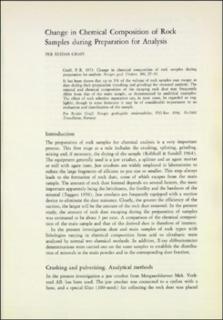| dc.contributor.author | Graff, Per Reidar | |
| dc.date.accessioned | 2020-08-26T13:11:50Z | |
| dc.date.available | 2020-08-26T13:11:50Z | |
| dc.date.issued | 1973 | |
| dc.identifier.uri | https://hdl.handle.net/11250/2674977 | |
| dc.description.abstract | It has been shown that up to 3% of the volume of rock samples may escape as clust during their preparation (crushing and grinding) for chemical analysis. The mineral and chemical composition of the escaping rock dust may frequently differ from that of the main sample, as demonstrated by analytical examples. The effect of such selective seperation can, in most cases, be regarded as negligible, though in some instances it may be of considerable importance in an evaluation and classification of the sample. | |
| dc.language.iso | eng | |
| dc.relation.ispartofseries | NGU (300) | |
| dc.rights | Navngivelse 4.0 Internasjonal | |
| dc.rights.uri | http://creativecommons.org/licenses/by/4.0/deed.no | |
| dc.subject | RØNTGENDIFFRAKSJON | |
| dc.subject | KJEMISK ANALYSE | |
| dc.subject | FLAMMEFOTOMETRI | |
| dc.subject | MINERAL | |
| dc.subject | METODE | |
| dc.subject | SPEKTROFOTOMETRI | |
| dc.subject | BERGART | |
| dc.title | Change in chemical composition of rock samples during preparation for analysis. | |
| dc.type | Journal article | |
| dc.description.localcode | 36229 | |
| dc.source.pagenumber | 27-31 | |

